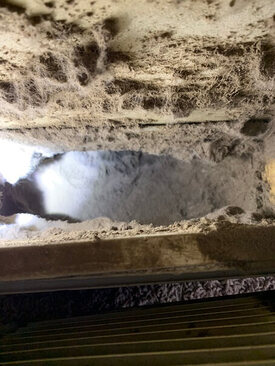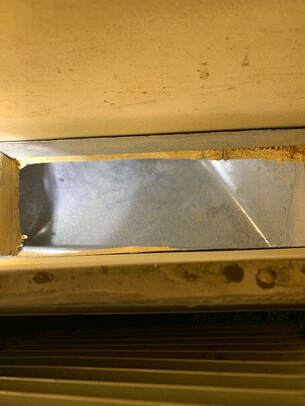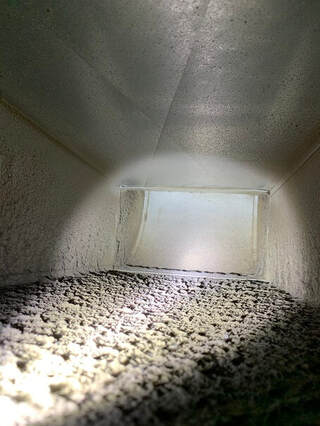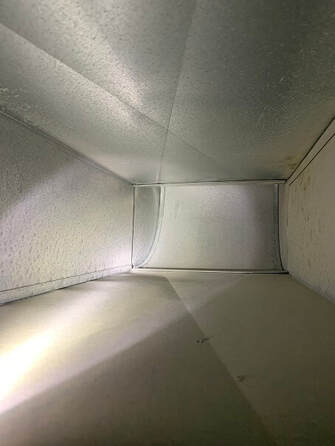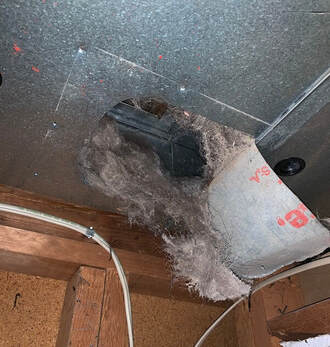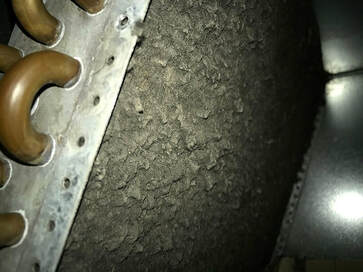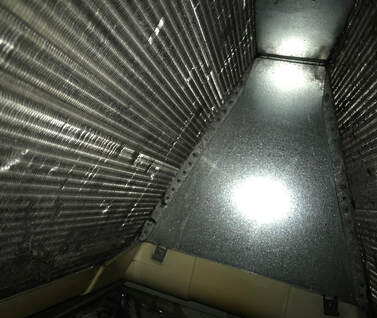|
Air ducts can get pretty dirty. Disgusting even, as the below photo shows. When your home's air ducts look like this, a run-of-the-mill air duct cleaning job isn't going to cut it. Why? Most basic-level air duct cleaning services feature high-pressured air as the mover of debris. But when said debris is abundant or "clingy" (e.g. drywall dust, pet fur), a more aggressive method is called for. Cleaning the branch lines The photo above was taken by one of our technicians in the branch line of a Minneapolis home, built in 2001, whose ducts had never been cleaned. As you can see, a lot of the debris is clinging to the walls of the duct, and the buildup is extensive. If this duct were to be cleaned with mere air pressure, a good deal of the debris would be pushed down the branch line into the main trunk for the vacuum to gobble up. But an unacceptable amount would be left behind, still clinging to the duct walls. During the Ultimate Duct Cleaning, the first step of the process is for the technician to slip a tool called the Viper Microline down the branch line. Its single flexible-plastic tentacle is ideal for the snug confines of a branch line. When this tool is engaged, it thrashes quickly and vigorously every which way inside the duct, dislodging debris from the duct walls and sending it airborne. The tool moves slowly down the vent and through the duct, with its forward-blowing air nozzle blasting the debris in front of it as it moves, pushing it toward the trunk lines. The technician will take the Microline to each branch-line vent, pushing the accumulative mass of debris into the trunk lines before moving to clean those. It is this physical contact of the tool with every inch of the duct wall that makes this level of cleaning so effective. Even stubbornly clinging dust stands no chance against the physical force of the Microline, as shown above. Cleaning the trunk lines Once the branch lines have been whipped, the technician moves to the main trunk lines to clean the debris accumulated from above. Because these ducts are much larger, the tool of choice here is the Viper Clean Sweep. This tool features six 16-inch long flexible-plastic tentacles, ideal for the roominess of main trunk lines. With an industrial vacuum in place at an access point created just before the furnace in the main return line, the technician inserts the tool—it requires only a 1-inch access point--at the other end. From there the action is similar to that of the Microline but on a larger scale. As the multiple tentacles whip aggressively to and fro inside the duct, debris is dislodged and rendered airborne. The forward-blowing air nozzles send airborne debris toward the vacuum, and debris that isn't airborne is pushed forward by the thrashing of the tentacles. Either way, the collective fate of the debris is to be whooshed down the vacuum at the end of the line. The process is then repeated in the main supply line. No top-of-the-line air duct cleaning would be complete without cleaning the furnace—the heart of the HVAC system. Since most homes with dirty ducts also have dirty furnaces, and since a dirty furnace will cause dirty air to move into the ducts, it makes sense to clean them both at once. Letting the tool speak for itself . . . No number of action words strung together in a sentence can convey the effectiveness of a tool better than a video of it in action:
0 Comments
We humans love our furry companions. And for some of us, let's face it, our perception of their cuteness directly correlates with their level of fluffiness (with exceptions, of course). Alas, our heating and cooling systems do not find their fluffiness so adorable. The monstrosity below was encountered by one of our technicians at a home in Plymouth, MN, when he created an access hole in their main return duct. At the risk of stating the obvious, the homeowners had a large dog, and it had been many years since their ducts had been cleaned. Pet fur inside the air ducts Those of us with pets know how ubiquitous their fur is—it's everywhere! As your pet moves around the home, loose hair becomes airborne and comes to rest on the carpet, on furniture, in your food(!), and in the vents. Since animal fur strands are generally much larger than run-of-the-mill household dust, they get hung up much more easily than smaller particles. Once hung up inside the ducts, they become a magnet for more fur and for other debris, creating mats of fur and dirt like the one pictured above. Pet fur also builds up much more quickly inside the ducts. Whereas typical household dust takes years to build up to an extent that it needs to be removed, animal fur, because of its size and the sheer volume of it, reaches critical mass sooner. Consequently, while people without pets can get by on a standard or "maintenance-level" air duct cleaning every two years, as recommended, those with pets may wish to have the higher level of service performed as their "maintenance" duct cleaning. Pet fur inside the furnace Once pet fur is inside the vents, it moves through the ducts and, under normal circumstances, will be stopped from entering your furnace by the air filter. There on the filter it builds up and, unless the filter is changed regularly, it will become clogged with fur. With some frequency, our technicians have seen filters become so clogged that air cannot move through them, and the filter then bends and can even potentially be sucked into the furnace (and on at least one occasion, ripped apart by the blower wheel!). Once the filter is clogged to this extent and bent, it is of course no longer functioning as a filter of any kind. At this point filter bypass comes into play, where debris simply goes right around the filter into the furnace. (Filter bypass can also occur when an air filter is ill-fitting, incorrectly installed, or extremely low-quality, such as cheap fiberglass, for example.) The last place you want pet fur: the evaporator coil It's inside the furnace and its various components that pet fur becomes extremely problematic, settling into the individual parts, clogging them up and reducing air flow. Since the entire heating and cooling system relies on good air flow to function optimally, efficiency can be greatly reduced when air flow is compromised by fluffy-furry debris. The evaporator coil (A coil) is particularly susceptible to buildup, since all the air that circulates through your HVAC system passes through it. Both the furnace and the air conditioner will lose efficiency, work harder, and be subject to break-downs when air flow through the evaporator coil is compromised. The close-up above shows a mat of pet fur choking off air flow on the delicate fins of the coil. Because of the sheer size and "magnetic" quality of animal fur, if it manages to bypass the filter and reach the evaporator coil, it has the potential to disrupt the entire system Above is what the evaporator coil should look like without its fur coat, the tiny holes free and clear of debris, allowing for easy movement of air and for the transfer of heat. If the coil above had a face, it'd surely have a smile on it.
Cleaning fur from the HVAC system Considering the potential ravages of animal fur on the heating and cooling system, and that preventive maintenance is always a better (and less costly) option than repair, homeowners with pets should consider opting for the highest level of air duct cleaning service, including a furnace cleaning. Thereafter they should opt for at least the mid-level service as a maintenance cleaning. Why? Because for most companies, the top-tier service would include use of a tentacled air whip or brush used on the main trunk and the branch lines. The physical contact of the tool against the walls of the ducts—as opposed to the mere blowing that air pressure would provide—would aid in loosening any pet fur clinging to them. A thorough furnace cleaning would then remove from the inner components of the furnace any fur that made it past the filter—hopefully before it becomes too abundant and reaches the evaporator coil. So as a savvy homeowner and a diligent pet owner, in addition to frequently vacuuming your carpet to remove pet hair from all the places you can see it, consider having your air ducts cleaned frequently to remove it from all the places you can't .Wanna dig deeper? Download our free tipsheet: 10 Questions to Ask Before Hiring an Air Duct Cleaning Company. Download Tipsheet Many thanks to our technicians Ben S and Roy S for lending their expertise to this article. |
SearchArchives
April 2022
|
Twin Cities Furnace Cleaning - Open 7 Days a Week 8AM to 8PM

